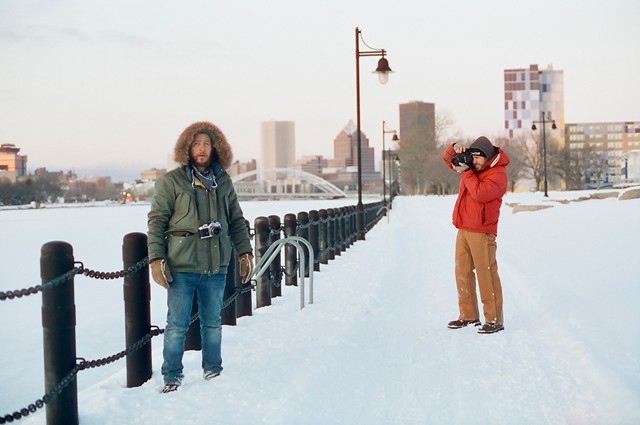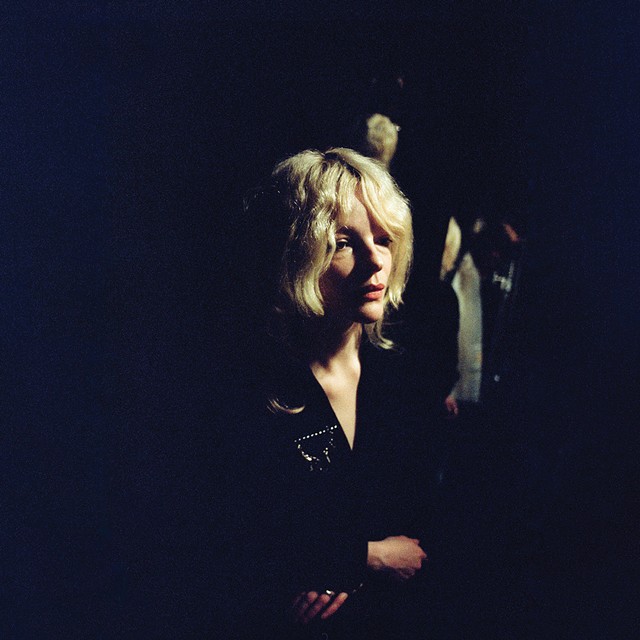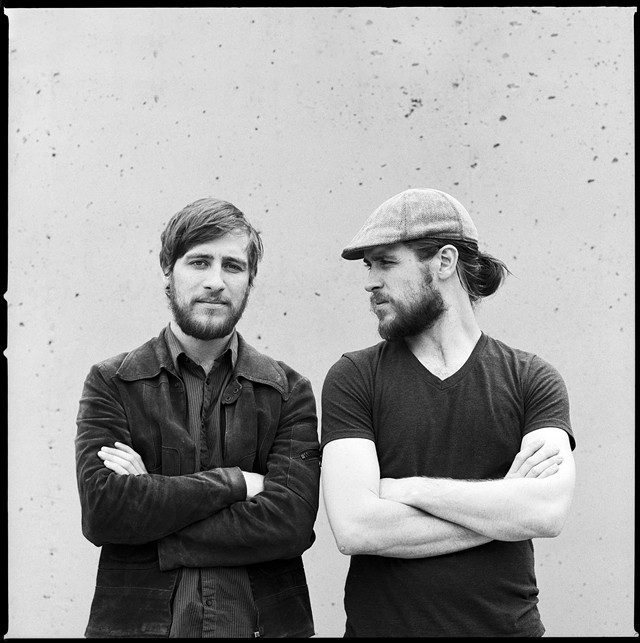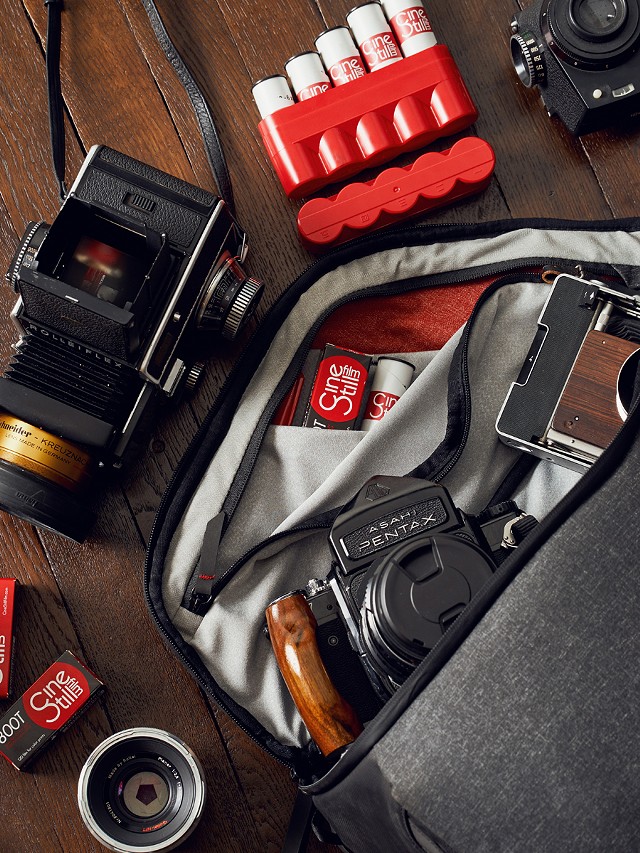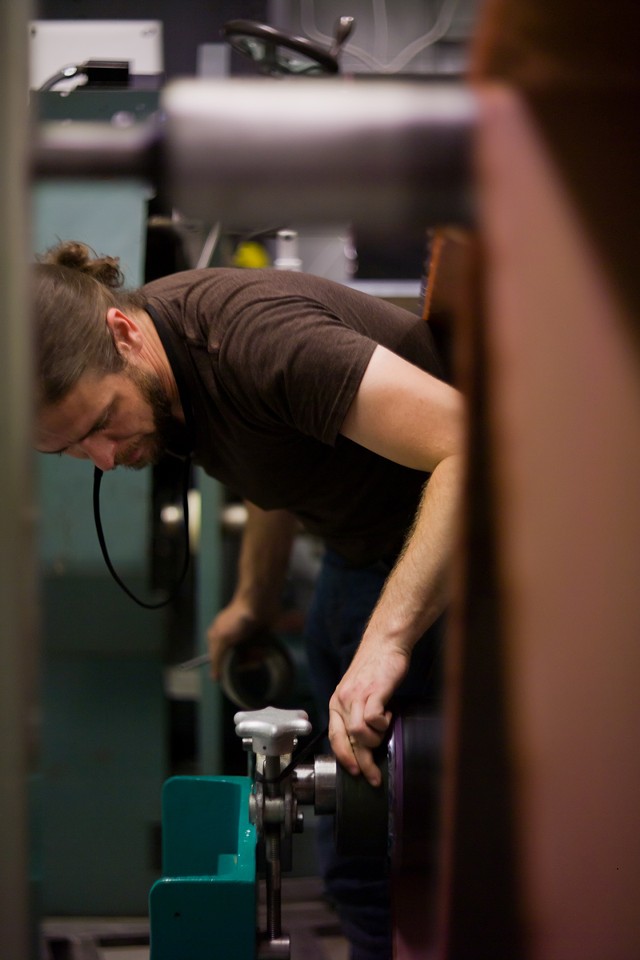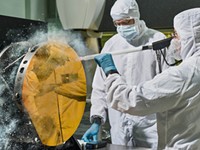[
{
"name": "500x250 Ad",
"insertPoint": "5",
"component": "15667920",
"parentWrapperClass": "",
"requiredCountToDisplay": "1"
}
]
California folk singer Jessica Pratt’s music sounds like a memory; warm and glowing, with one eye open to the mysterious. For the cover of her newest release, “Here in the Pitch,” Pratt sought a cameraperson — and a film — that evoked the same energy.
“Jessica wanted the artwork to feel like it was taken by an undetected photographer that had suddenly gained access to an inner sanctum,” Nina Gofur, who snapped the artwork, wrote on Instagram in May. “For this reason, CineStill 800T felt it could transmute this suspended reality.”
800Tungsten, or 800T for short, is the flagship product of Los Angeles-based film company CineStill, which launched in 2012. Its unmistakable warm tone renders neon night scenes and cozy interiors with a look the CineStill founders call “magical.”
And it’s produced right here in Rochester.
“If you go into a lowly lit restaurant and you're still wearing your sunglasses, that's how all other color film will capture indoor photography — yellow-orange colors and really dark,” CineStill co-founder Brandon Wright said. “800T is like, if you took your glasses off tonight, you can see everything.”
Wright would know. With his twin brother Brian, he developed a process for converting Kodak 35-millimeter motion-picture film into ready-to-use, portable camera film intended specifically for still photography. The resulting innovation of the Brothers Wright, as they’re known — not to be confused with that other pioneering Wright duo — is 800T, and it can turn ordinary snaps into cinematic moments.
Though they run CineStill out of a Hollywood-based office, every roll of 800T fittingly begins its journey at the Eastman Business Park. Brandon and Brian make the trek east four or five times per year with Daniel McDonald, CineStill’s dealer and operations manager, to prep the next batches. Brandon calls the process more artisanal than automated.
“It requires a little bit of expertise, a little bit of whispering to it,” he said.
As they started up CineStill in L.A., the Wrights used leftover Kodak film, then eventually bought factory-sealed 35-millimeter rolls from the company in large volumes. When they expanded to include higher-resolution 120 film, they came to a crossroads: build a new machine for production in Hollywood and pay heaps in shipping costs, or find an existing space that had the infrastructure they needed and room to build a new machine to make their film.
One such space? Eastman Business Park in Rochester.
“They basically sold us on it,” Brandon said. “We could either pay 10 times the rent in Los Angeles and not have the facilities we need or have a small space for an absolute bargain.”
When the brothers first came here in 2015, they stayed in Greece. They kept hearing good things about South Wedge, so on return trips, they rented Airbnbs near, and frequented, the now-shuttered institution Tap and Mallet. “The week that they closed [in 2021], we were coming out here. We got an Airbnb right across the street,” Brandon said. “We show up, and it’s closed.”
These days, when they’re back in their “second home,” the twins can be found near Park Ave., at Good Luck and around the Public Market.
“Cure is our Sunday night spot,” Brandon said. “If we're in town and you pop by Cure around 8 p.m., we'll probably be there.”
CineStill’s bicoastal process — film produced here, business headquartered out west — is loaded with meaning given the ongoing marriage between the Photo City and Tinseltown.
“We enjoy the history of Rochester,” Brian said, referencing the film boom of the early 20th century as powered by Kodak. “Rochester and Hollywood have been intertwined from the beginning.”
His brother took it further.
“Hollywood wouldn’t exist without Rochester and Kodak.” To that end, their jetsetting feels intentionally symbolic, even if it also makes smart business sense.
The CineStill production process is proprietary, but it involves shedding the motion-picture film’s protective layer, called Remjet. The chemicals prevent instances of light spreading, or ‘halation,’ beyond its boundaries. But those chemicals won’t work with standard still-image processing, so they’re removed for a simpler experience for the photographer. As a result, 800T gains its distinctive look.
A quick Instagram search of #CineStill800T yields hundreds of images; red tail lights, glowing signs and overhead bulbs radiate and pop due to halation. Local photographer and videographer Roberto Felipe began shooting with 800T three or four years ago due to its versatility in different lighting situations.
“It's one of the few films that can handle warm tones and cool tones in the same scene and render them accurately but still with its own kind of unique character to it,” he said. “Those always end up looking kind of like scenes from a movie.”
One scene from Felipe finds newlyweds driving off in a vintage pale-blue Ford on a warm San Diego street. A red spark of halation and a light leak cuts through the middle of the frame like a finish-line ribbon turned vertical. “It’s a nice little cherry on top,” he said.
In photo shoots, 800T has likewise made musicians look like incandescent stars. When Paramore returned with their first album in six years, 800T captured the trio in eerie summer-storm lighting on the cover of 2023’s “This Is Why.” Singer-songwriter Maggie Rogers and countryish performer Medium Build have also been highlighted.
This partnership between photo and music harkens back to the Wrights’ origins as concert photographers and music documentarians.
“We also did weddings out here in Los Angeles, 100 percent on film,” Brandon said. “That actually paid most of the bills because there's not a lot of money in music photography.”
They both laughed. “Hit or miss,” Brian said.
Running a film company in 2024 fits into a larger “analog renaissance” that Brian mentioned in interviews from a decade ago. After all, vinyl records are now a $1.4 billion industry annually. “Digital is no longer the latest and greatest. It just is,” he told PetaPixel in 2014. “In 10 years, technology will make [analog] options even more accessible and result in even higher quality than we already have.”
In 2024, digital’s latest innovation — artificial intelligence — makes users crave reality even more. And CineStill uses digital, of course, but as a tool to have analog experiences.
“We use Instagram to show people digitally what analog film looks like,” Brian said, “shot by a real person and not manipulated.”
Jessica Pratt’s “Here in the Pitch” cover portrait, for example, remains captivating in part because it hasn’t been altered. The singer opts for a cinematic metaphor about an evolving relationship on the album’s final track: “The storyline goes on forever.” The photo may, too.
Patrick Hosken is an arts writer at CITY. He can be reached at [email protected].
“Jessica wanted the artwork to feel like it was taken by an undetected photographer that had suddenly gained access to an inner sanctum,” Nina Gofur, who snapped the artwork, wrote on Instagram in May. “For this reason, CineStill 800T felt it could transmute this suspended reality.”
800Tungsten, or 800T for short, is the flagship product of Los Angeles-based film company CineStill, which launched in 2012. Its unmistakable warm tone renders neon night scenes and cozy interiors with a look the CineStill founders call “magical.”
And it’s produced right here in Rochester.
“If you go into a lowly lit restaurant and you're still wearing your sunglasses, that's how all other color film will capture indoor photography — yellow-orange colors and really dark,” CineStill co-founder Brandon Wright said. “800T is like, if you took your glasses off tonight, you can see everything.”
Wright would know. With his twin brother Brian, he developed a process for converting Kodak 35-millimeter motion-picture film into ready-to-use, portable camera film intended specifically for still photography. The resulting innovation of the Brothers Wright, as they’re known — not to be confused with that other pioneering Wright duo — is 800T, and it can turn ordinary snaps into cinematic moments.
Though they run CineStill out of a Hollywood-based office, every roll of 800T fittingly begins its journey at the Eastman Business Park. Brandon and Brian make the trek east four or five times per year with Daniel McDonald, CineStill’s dealer and operations manager, to prep the next batches. Brandon calls the process more artisanal than automated.
“It requires a little bit of expertise, a little bit of whispering to it,” he said.
As they started up CineStill in L.A., the Wrights used leftover Kodak film, then eventually bought factory-sealed 35-millimeter rolls from the company in large volumes. When they expanded to include higher-resolution 120 film, they came to a crossroads: build a new machine for production in Hollywood and pay heaps in shipping costs, or find an existing space that had the infrastructure they needed and room to build a new machine to make their film.
One such space? Eastman Business Park in Rochester.
“They basically sold us on it,” Brandon said. “We could either pay 10 times the rent in Los Angeles and not have the facilities we need or have a small space for an absolute bargain.”
When the brothers first came here in 2015, they stayed in Greece. They kept hearing good things about South Wedge, so on return trips, they rented Airbnbs near, and frequented, the now-shuttered institution Tap and Mallet. “The week that they closed [in 2021], we were coming out here. We got an Airbnb right across the street,” Brandon said. “We show up, and it’s closed.”
These days, when they’re back in their “second home,” the twins can be found near Park Ave., at Good Luck and around the Public Market.
“Cure is our Sunday night spot,” Brandon said. “If we're in town and you pop by Cure around 8 p.m., we'll probably be there.”
CineStill’s bicoastal process — film produced here, business headquartered out west — is loaded with meaning given the ongoing marriage between the Photo City and Tinseltown.
“We enjoy the history of Rochester,” Brian said, referencing the film boom of the early 20th century as powered by Kodak. “Rochester and Hollywood have been intertwined from the beginning.”
His brother took it further.
“Hollywood wouldn’t exist without Rochester and Kodak.” To that end, their jetsetting feels intentionally symbolic, even if it also makes smart business sense.
The CineStill production process is proprietary, but it involves shedding the motion-picture film’s protective layer, called Remjet. The chemicals prevent instances of light spreading, or ‘halation,’ beyond its boundaries. But those chemicals won’t work with standard still-image processing, so they’re removed for a simpler experience for the photographer. As a result, 800T gains its distinctive look.
A quick Instagram search of #CineStill800T yields hundreds of images; red tail lights, glowing signs and overhead bulbs radiate and pop due to halation. Local photographer and videographer Roberto Felipe began shooting with 800T three or four years ago due to its versatility in different lighting situations.
“It's one of the few films that can handle warm tones and cool tones in the same scene and render them accurately but still with its own kind of unique character to it,” he said. “Those always end up looking kind of like scenes from a movie.”
One scene from Felipe finds newlyweds driving off in a vintage pale-blue Ford on a warm San Diego street. A red spark of halation and a light leak cuts through the middle of the frame like a finish-line ribbon turned vertical. “It’s a nice little cherry on top,” he said.
In photo shoots, 800T has likewise made musicians look like incandescent stars. When Paramore returned with their first album in six years, 800T captured the trio in eerie summer-storm lighting on the cover of 2023’s “This Is Why.” Singer-songwriter Maggie Rogers and countryish performer Medium Build have also been highlighted.
This partnership between photo and music harkens back to the Wrights’ origins as concert photographers and music documentarians.
“We also did weddings out here in Los Angeles, 100 percent on film,” Brandon said. “That actually paid most of the bills because there's not a lot of money in music photography.”
They both laughed. “Hit or miss,” Brian said.
Running a film company in 2024 fits into a larger “analog renaissance” that Brian mentioned in interviews from a decade ago. After all, vinyl records are now a $1.4 billion industry annually. “Digital is no longer the latest and greatest. It just is,” he told PetaPixel in 2014. “In 10 years, technology will make [analog] options even more accessible and result in even higher quality than we already have.”
In 2024, digital’s latest innovation — artificial intelligence — makes users crave reality even more. And CineStill uses digital, of course, but as a tool to have analog experiences.
“We use Instagram to show people digitally what analog film looks like,” Brian said, “shot by a real person and not manipulated.”
Jessica Pratt’s “Here in the Pitch” cover portrait, for example, remains captivating in part because it hasn’t been altered. The singer opts for a cinematic metaphor about an evolving relationship on the album’s final track: “The storyline goes on forever.” The photo may, too.
Patrick Hosken is an arts writer at CITY. He can be reached at [email protected].
Latest in Culture
More by Patrick Hosken
-

Reel to real
Jun 24, 2024 -

Concert Review | Taj Mahal
Jun 22, 2024 -

Jazz Fest performers keep other musicians' legacies alive
Jun 21, 2024 - More »
Readers also liked…
-

Telltale signs
May 17, 2024
